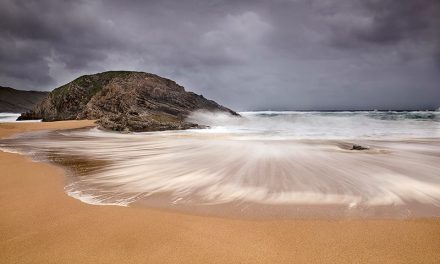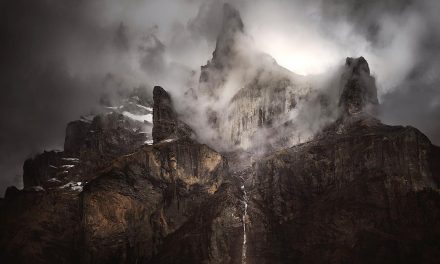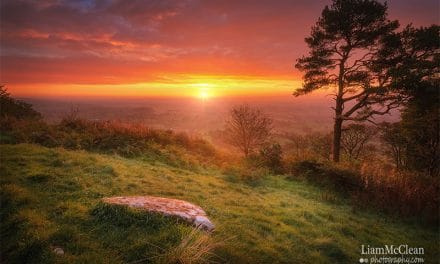Looking for some inspiration to start your photography hobby or as a career? Read on and witness the different photographers that we’ve interviewed for this article. For your additional inspiration we’ve interviewed other photographers, please refer to this link.
Destin Sparks
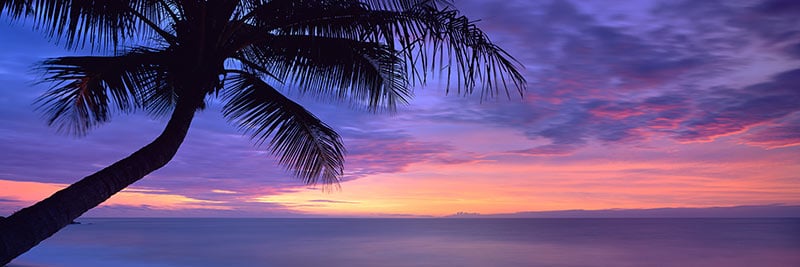
Elysium
Destin Sparks is an award-winning landscape photographer based in Queensland, Australia. Destin first got started with photography in 2009, and now he’s leading photography tours in Australia and New Zealand. In Destin’s portfolio, you’ll find many amazing panoramic images.
I recently had the opportunity to interview Destin about his work, and you’ll find his responses to my questions below. I’m sure you’ll also enjoy the sampling of his photography that is featured in the interview.
Tell us a little bit about yourself and how you got started in photography.
Hello Loaded Landscapes community, my name is Destin Sparks. I’m a professional photographer from Australia. My specialty is panoramic format landscapes using film and digital medium format cameras to create my works. I travel the globe in search of mother nature’s greatest creations, some of my favorites include Yosemite Valley (California), Moraine Lake (Canadian Rockies), and South Island (New Zealand) just to name a few.
I find myself drawn to mountainous landscapes due to their unpredictable microclimates. The weather surrounding mountains can be truly fascinating to watch and even better to photograph.
My first foray into photography began around 10 years ago when I found myself in a camera store working in an unrelated field. My passion for photography can be attributed to my ‘at the time’ work associate who first challenged me to pick up the camera.
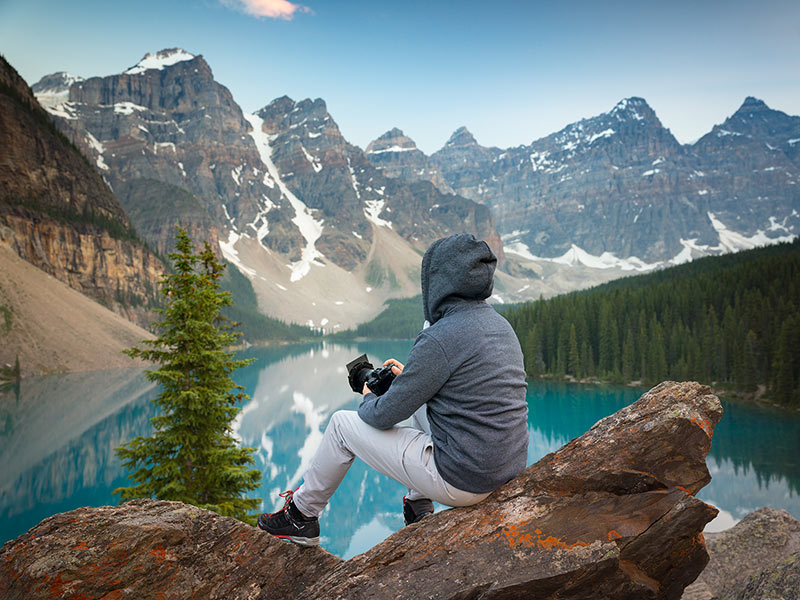
Destin Sparks
Do you have any formal photography training?
I’m completely self-taught. Everything I’ve learned is through trial and error. Mistakes can be costly when photographing with film, so you learn fast. I’ve always believed that photography is best learned through practice.
Sure, there’s a lot of theory behind photography and much of this is taught in a classroom but once you know the basics it’s physically getting out there and doing it that helps you understand what works and what doesn’t.
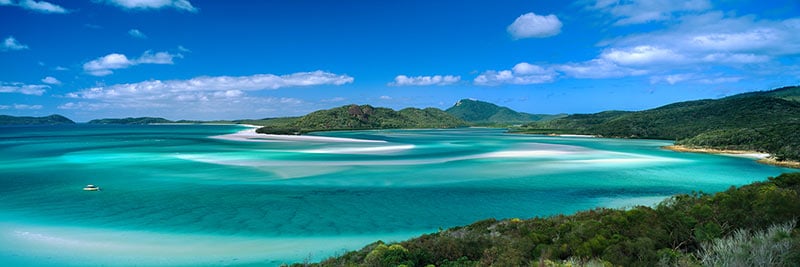
Chatoyant Bliss
What draws you to landscapes rather than other types of photography or subjects?
An impressive natural scene always could take my breath away. Whether it’s standing in front of a giant cascading waterfall, a snow-capped mountain or the azure water of a tropical island, nature’s beauty just mesmerizes me. I just don’t get that type of feeling from other types of photography.
That’s not to say I don’t appreciate a good portrait or a touching wedding photo, I just like to feel immersed by a scene. It’s also the adventure I seek.
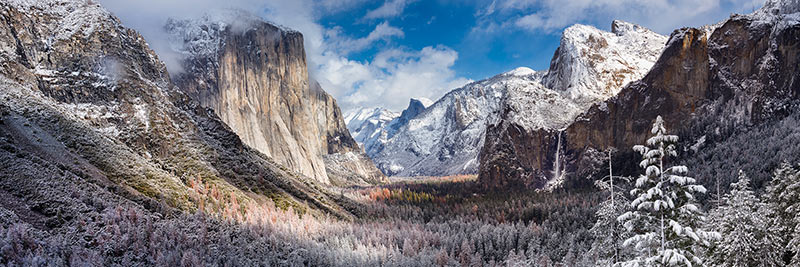
Yosemite Valley
How would you describe your photographic style?
Great question and I’m not sure I know the answer. The common theme among all the photos on my website would be ‘vivid’ and ‘panoramic’. I’ve always been fascinated by the rich colors of nature and love to feature that in my work.
I tend to stick to a theme for each photograph using just one or two dominant colors. I feel this adds a real impact to the finished works.
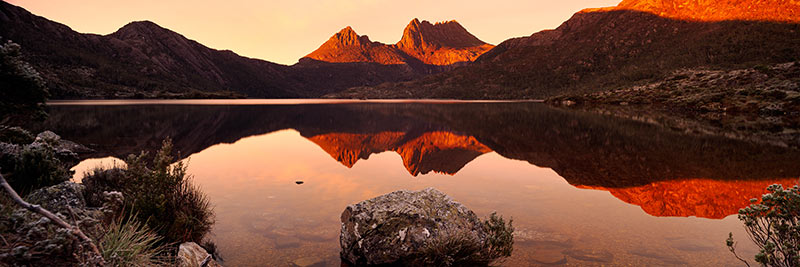
Razorback
Tell us a little bit about the two cameras you use, and in what situations you would use each of them.
My primary camera is the Fuji GX617, it’s my ‘go-to’ camera. It has a native panoramic format and can produce the most beautiful colors when paired with my favorite slide film (Velvia 50). Being completely analog, there are a few caveats I must consider when opting to shoot with this system.
It’s a slow camera and doesn’t lend itself well to low light or contrasty situations. It also uses up film very quickly, since an entire roll of 120 films is used within just 4 shots I must choose my compositions wisely.
The newer of my two cameras is the Phase One XF IQ3 100MP. It’s a medium format digital camera and can produce extremely detailed images, its sharpness is unmatched. I tend to reach for this system when lighting is very dynamic.
The Phase One handles low light and wider latitudes much better than film but doesn’t have that ‘organic’ feeling that film produces.
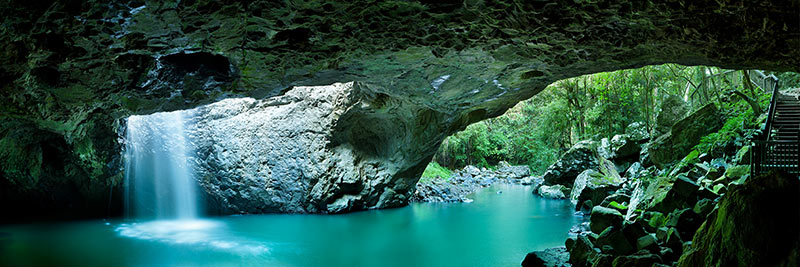
Naturality
Where do you find inspiration?
As a landscape photographer, I’m a very visual person. I tend to draw most of my inspiration from pictures and images. You’ll frequently find me scrolling through Instagram and flicking through magazines looking for new destinations to discover. Once I’m out on location I will spot a scene within a scene and just capture the moment.
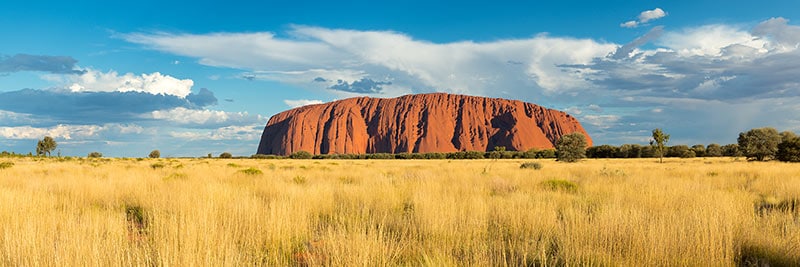
Red Centre
What is one important lesson that you have learned through your photography?
Stay true to yourself and don’t let the internet negatively influence your direction. It’s easy to get caught up following what other people are doing, especially on social media. If you enjoy photography, do it for yourself and yourself only. I feel this is one of the most important things I’ve learned and occasionally need to remind myself of.
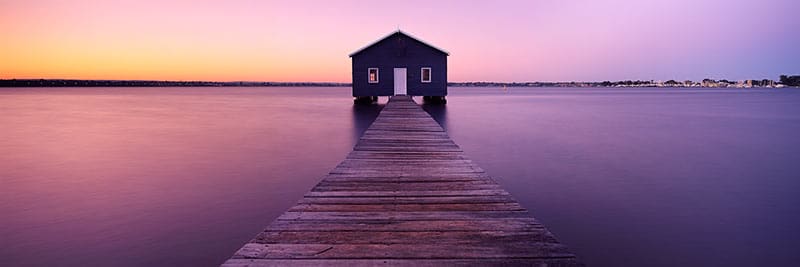
Timeless Bond
What are some common mistakes that you see new photographers making?
I see a lot of beginner photographers over editing their images. I’m not a Photoshop person myself, I like to capture everything in-camera, but I completely understand that some photographers like to process their images.
Where I see people going wrong is when they photograph a scene at the wrong time/day and try to turn it into something that it isn’t. The key to landscape photography is lighting. However, great light doesn’t come along often and beginners don’t have the patience to go back in the right conditions so they try to fake it with Photoshop.
This is a natural learning curve however, everyone eventually breaks the habit.
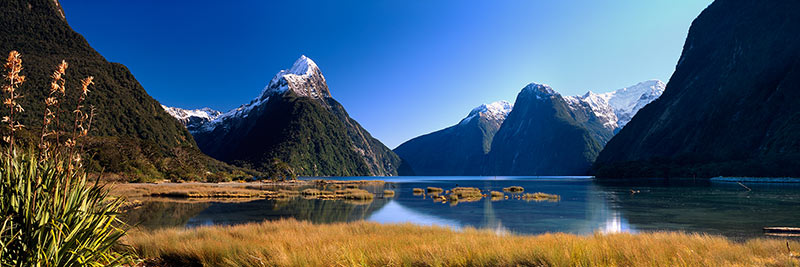
Sovereign
Tell us about a favorite spot in your local area that you like to shoot.
Living in Brisbane, Queensland I’m fortunate to have the Sunshine Coast and Gold Coast an hour’s drive North & South of me. Both coasts offer beautiful beaches but it’s the hinterlands I’m attracted to. Lamington National Park in the Gold Coast boasts over 500 waterfalls. It’s hard to surpass the natural beauty of our local tropical rainforests.
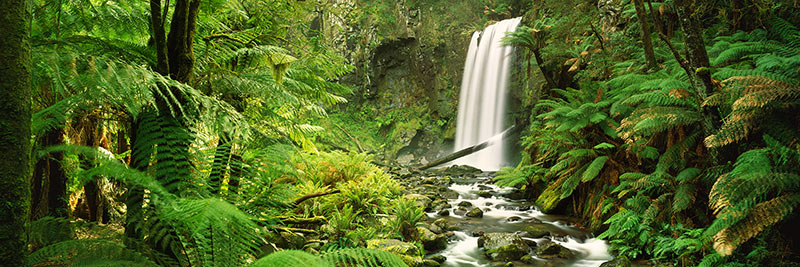
Sanctity of Light
Aside from photography, what hobbies do you have, or what do you like to do for fun?
I would describe myself as somewhat of a foodie. When I’m not photographing I like to be outdoors. We have great weather here in Queensland almost all year round.
Since I often travel to colder climates for photography I enjoy being out in the afternoon sun and near the water, usually kicking back on a picnic rug with a glass of wine in hand.
I also run photo tours for a handful of participants at a time, being small groups it’s quite a relaxed environment. It’s almost therapeutic educating and teaching enthusiasts some of my techniques and revealing my favorite photo spots.
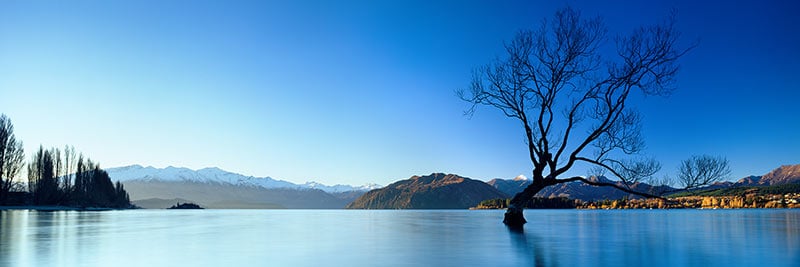
Night Guardian
Connect with Destin
If you’d like to see more of Destin’s work or get in touch with him, please use the links below.
All photos in this post are © Destin Sparks, used with permission.
David M. Cobb
David M. Cobb is a photographer based in Oregon who focuses on landscape, travel, and wildlife photography, as well as flowers and gardens. His books include Visionary Landscapes, America: Wild Landscapes, and Quiet Beauty: Japanese Gardens of North America. Long-distance hiking is a favorite activity for David, and he has hiked the Pacific Crest Trail, the Continental Divide, and across Iceland.
I recently had the opportunity to interview David about his photography, and I am sure you’ll enjoy reading the interview below.
Tell us a little bit about yourself and how you got started in photography.
I started out wanting to be a painter and studied art, art history, and composition. When I saw what Edward Weston could do with a pepper in his “Pepper no. 30” photo, that’s when I got sucked into photography. I constantly borrowed my parent’s camera and that got me going.
Later, when I started to take long backpacking trips across the U.S., Canada, and Iceland I taught myself more about light, color, form, and expression; and my photography started to evolve into a more serious vocation.
What draws you to landscapes rather than other types of photography or subjects?
I do shoot a lot of macro and travel images too, but I’m taken with landscapes because I get mesmerized by how the light and the land have this symbiotic relationship in creating beauty on such a large scale. I never tire of that.
How would you describe your photographic style?
Since I’ve shot in a film for many years and also embraced digital, my style has more of a feel for realism. It’s a bit of a bridge between the landscape photographs of the film era and the dreamier art landscape images of the digital era.
As a long-distance hiker, you face certain challenges that you wouldn’t face simply photographing from places that are easy to reach. Can you tell us a little about the planning and preparation that is needed?
First off, when I take a long-distance walk of 2,000-3,000 miles it’s not about photography. I walk an average of 20+ miles a day, so I don’t have time to capture sunrises or sunsets. I take a trusty point-and-shoot along to record the trip, but other than that I concentrate on walking. For meal preparation, I cook and dehydrate much of my food, so I get enough calories and eat healthy along the way.
Physically, things are always tough at the beginning, but then you get used to the pace of the day and life gets easier. Mostly the challenges are mental. There are a million reasons to quit and go home, especially when the weather is crappy day after day. Staying on the trail during those mental lows is what helps me complete those long-distance walks.
Tell us about a few of your favorite places to hike.
I like walking close to home in my stomping grounds of the Columbia River Gorge. I’m currently walking sections of the Chinook Trail which circumambulates the entire Columbia Gorge National Scenic area. I’ve hiked the 42-mile trail around Mount Hood in Oregon about a dozen times, and I usually do that in a couple of days.
Other than that, I’m returning to places I’ve loved during my long-distance walks to spend more time there with my camera and to just enjoy the scenery.
Do you have any upcoming trips planned?
In 2018 I plan on traveling more in Canada, and I’ll also be in Holland, Belgium, Montenegro, Bosnia, South Korea, and China. I’m hoping to get into the backcountry of the White Cloud Mountains in Idaho too.
What is the best advice you’ve ever received from another photographer?
Don’t take another step backward. Seriously though, Jack Dykinga told me you must tell a story about yourself or your images, and I still think about that today.
What software do you use for post-processing?
I’m probably one of the few out there still using Adobe Camera Raw over Lightroom, so that’s where I do my initial processing, then I do my fine-tuning in Photoshop.
What are some common mistakes that you see new photographers making?
A lot of new photographers spend too much time on sites like 500px (and others like it) to mimic, comp stomp, or copy other images. That’s fine at the beginning when you’re starting, but at some point, you need to concentrate on your work and break away to develop your style.
Aside from photography, what hobbies do you have, or what do you like to do for fun?
As you know, I get out into the backcountry when it’s possible. I also swim most days that I’m in town, and I read a lot. I’m also a film buff and a Minnesota Vikings football fan. I’ve recently completed my second book with Tuttle Publishing too titled Visionary Landscapes, depicting gardens of the five top Japanese garden designers in the U.S.
Connect with David:
If you’d like to get in touch with David or learn more about his work, please use the links below.
All photos used in this post are © David M. Cobb, used with permission.
Edan Raw
Edan Raw is a landscape photographer from the Sunshine Coast of Australia. His portfolio includes a lot of panoramas and beautiful seascapes. I recently had the opportunity to interview Edan about his work, and you can see his responses below.
You’ll also see many of his photos showcased throughout the interview.
Tell us a little bit about yourself and how you got started in photography.
My introduction to photography was when I was working away doing whats called fly in fly out, FIFO for short, mining construction. One of my workmates was a pretty keen photographer and I was pretty amazed by the creative in-camera sort of stuff he was doing with his DSLR, so I lashed out and bought one myself. That was a Canon 500D, nothing special these days but it was enough to get me started.
How would you describe your photographic style?
I love my panoramas! Every scene I look at I first think “will this work as a pano?” haha. I like to think that I have developed my style along the way, as much as possible these days anyway. I try my best to keep things as natural as possible and try to keep I guess what you would call a traditional landscape photography style. I’m not a big fan of bringing out to many shadows. I love the contrast.
What draws you to landscapes rather than other types of photography or subjects?
I think where I grew up and also my parents’ influence has a lot to do with it. I grew up in a place called Forest Glen and as the name suggests it’s a pretty densely forested area so I spent most of my childhood climbing trees and getting bitten by jumping ants. My parents always encouraged me to get outdoors and instilled a deep appreciation for the natural world from as early as I can remember.
So I have always loved the outdoors and that has turned into a passion for landscape photography.
Where do you find inspiration?
My original inspiration for going down the path of landscape photography was Australian panoramic photography master Ken Duncan. I just love his eye and what he captures on a panoramic film camera. So basically I just really study the compositions of people’s work I admire, people like Christian Fletcher, a lot of Australian photographers, because that’s where I mostly want to shoot.
Other than that nature itself. What is more inspirational than being by your self somewhere off the beaten path watching a beautiful sunrise unfold in front of you?
What is one important lesson that you have learned through your photography?
I would have to say perseverance and I guess patience comes with that. I have got so many photos bouncing around in my head that I am waiting to nail but the heavens haven’t quite aligned just yet. Also to take a leap and back yourself and put your self out there and open yourself up to criticisms and judgment from others, self-doubt, all the questions and doubts that you have running around your mind when stepping out of your comfort zone and challenging yourself.
What software do you use for post-processing?
My editing skills are pretty abysmal I’m afraid. I think that side of things has been a little slower for me as I am not very tech minded so it’s been a steep learning curve. I feel I am just getting to that stage almost 3 years on where I can edit my photos to accurately recreate the scene before me. I use Lightroom and Photoshop and that’s it.
What is your typical process for planning and scouting?
The majority of what I consider my best work has been scouted beforehand and even shot half a dozen times before capturing what I want. On the other hand, my most popular image was a stroke of luck. I usually carry my camera around with me in the car with my go-to 24-70mm.
I am loaning a mates Fuji G617 with the fixed 105mm at the moment and trying to get my head around that beast. I’ve never shot a roll of film in my life so that will be interesting. There is nothing more satisfying for me than to see a composition, scout it, wait for the stars to align, and then capturing that scene in time and turning it into a piece of art.
Can you tell us about a few of your favorite locations to photograph in your local area?
I love the Glass House Mountains and All the Sunshine Coast Hinterland. Such an incredible area with so many little hidden gems, I have only just scratched the surface. The Sunshine Coast is also blessed with golden beaches and beautiful subtropical forests with waterfalls around every corner so it’s not too hard to get motivated to get out and shoot.
What are the biggest challenges you face in your work as a landscape photographer?
I think in this day and age with every second person owning a DSLR it is getting harder and harder to capture unique compositions and perspectives. So that’s what I challenge myself to do most. To turn my back on the obvious photo and try and find something unique. Other than that just trying to get my work out there and recognized.
Aside from photography, what hobbies do you have, or what do you like to do for fun?
Surfing, hanging at the beach. I have an interest in nutrition and alternative medicine so I’m always reading articles on that sort of thing. Boxing and calisthenics style stuff for a bit of exercise. Pretty busy at the moment with learning how to build websites so that is kind of a hobby/business that is keeping me busy.
Connect with Edan
If you’d like to get in touch with Edan or see more of his work, please use the links below:
All photos in this post are © Edan Raw, used with permission.
Mark Brodkin
Mark Brodkin is an accomplished landscape photographer from Canada who travels the world to capture amazing scenes. I recently had the opportunity to interview Mark for Loaded Landscapes. I’m sure you’ll enjoy getting to know more about him, as well as browsing the inspiring samples of his work included throughout the interview.
Tell us a little bit about yourself and how you got started in photography.
I was born and raised in Toronto, Canada and have lived in New York and Washington DC. In pursuit of my images, I have traveled through Canada, the United States, South Africa, Namibia, Japan, China, Singapore, Cambodia, Vietnam, Laos, Thailand, India, Australia, New Zealand, Germany, Brazil, Argentina, Chile, Peru, Costa Rica, Panama, Cuba, Morocco, Greece, France, Jordan, Mexico, Saint Lucia, Israel, Iceland, and Turkey.
My images have appeared globally in Vanity Fair, Conde Nast Traveler, Outdoor Photographer Online, The Daily Mirror, and the Toronto Star. In 2014, my image “Out from the Fog” was awarded Canadian Photograph of the Year.
I started shooting travel photography while on vacation in Thailand in 2007. My love for photography grew and in 2009 I traveled through Southeast Asia and India in pursuit of images. Upon my return, I had my first private show and began selling my work through art galleries in Toronto.
Since then I have been in 17 shows and sold my images around the world. Photography remains my true passion and connects me to the most incredible places on our planet.
Do you have any formal photography training?
I do not have any formal training. All of my training has come from online resources, working with other photographers and real-world experience. As a landscape photographer, outdoor skills and the ability to predict the weather are key components for success. With every trip, I continue to build on my base of experiences and hopefully improve my skills.
What draws you to landscapes rather than other types of photography or subjects?
There is something incredibly uplifting about standing before the most incredible natural beauty in incredible light. As a landscape photographer, I can witness nature during her finest moments. For this, I am truly grateful. There is also the incredible thrill of shooting when the conditions are great. There is no certainty that nature will cooperate so when it does, the experience is exhilarating.
How would you describe your photographic style?
My goal in photography is to move the viewer emotionally as I was moved when witnessing the scene in my image. Through capturing incredible moments in the field and thoughtful post-processing techniques, I attempt to recreate the thrill I felt while shooting. If anything, I would describe my style as emotional and passionate. I am an artist, not a journalist and my work is intended to inspire as opposed to purely recording the scene I witnessed.
Where do you find inspiration?
Inspiration is everywhere. I am inspired by the natural beauty in the locations I shoot. I am also inspired by the incredible work of other nature photographers. Often, for inspiration, I will look at thousands of images from the best photographers online. On location, I need not look far to be inspired by the incredible beauty of nature.
How do you prepare before a shoot?
I prepare extensively for every shoot. In advance of visiting, I spend hours online looking at images shot from a particular location. I also study google maps to understand the terrain and distances between locations on my shot list.
As I get closer to a shoot, I begin to study the weather and tide tables. For each shoot, I prepare to have multiple shooting locations available and try to chase the best weather. When possible I speak with other photographers who have been to the location and when I arrive I always speak with locals and other photographers I meet in the field.
Preparation is a key component for success and a big part of my process.
What are your most essential gear/accessories?
I shoot with a Nikon D850. My essential lenses are the 14-24mm, 16-35mm, 24-70mm, 70-200mm and 24mm Tilt-Shift. I carry an RRS tripod with a panorama head. For filters, I have a 3 stop ND filter and a circular polarizer. I also carry a Hoodman loupe.
What are the biggest challenges you face in your work as a landscape photographer?
The biggest challenge is finding the time to be in a location long enough to get good light. In some cases, getting to the location is also a big challenge. Often locations are hard to access and to be shot in good light requires hiking in or out in the dark. Another challenge is originality.
It is hard today to make an original image and many of the iconic images have been overshot by an ever-growing population of photographers. I combat this mostly in post-production where the artistic possibilities are endless.
Do you have a dream location that you have not been to yet?
I would like to shoot Havasu Falls in the Grand Canyon and the Great Migration in Tanzania, both of which I plan on doing this year. Norway, Scotland, and Tuscany are also on my list.
Aside from photography, what hobbies do you have, or what do you like to do for fun?
I have a Golden Retriever puppy and an 18-month old daughter who keep me quite busy. I am a huge baseball fan and love visiting stadiums across the United States. For sports, I like to ski and scuba dive when time permits. And, of course, I absolutely love to travel.
Connect with Mark
If you’d like to see more of Mark’s work or to get in touch with him, please use the links below:
Photos used in this post are © Mark Brodkin, used with permission.
Jakub Polomski
Jakub Polomski is a self-taught landscape photographer from Poland. He specializes in mountain photography and aerial photos taken by a drone. His portfolio is filled with beautiful photos from locations around the world, with a heavy dose of European landscapes. I recently had the opportunity to interview Jakub about his work, and you can read his responses below.
You’ll also see several of his photos showcased throughout the interview.
Tell us a little bit about yourself and how you got started in photography.
I live in Cieszyn – a small town in the south of Poland. I am 32 years old. Twelve years ago I saw some pictures in an issue of National Geographic Magazine. They inspired me.
I borrowed a camera from my friend and I have started my adventure with this field of art (never before had I had my camera because I hadn’t been interested in photography). I have never had any “formal” training. I also didn’t learn photography in any school. I was uploading my photos onto many photo portals and I was reading feedback to them. These constructive critiques helped me to improve my skills.
What draws you to landscapes and nature?
I especially love the mountains. When I am trekking in the mountains I feel great respect for nature. By taking pictures of the mountains I want to show how great they are, and how small human is in comparison to them. This is some kind of giving honor to the greatness of nature.
What advice do you have for photographers who want to get started with drone photography?
Photographing by drone, in my opinion, is more difficult. Mainly because you have unlimited in no way composition capabilities. The second difficult thing is that you have to focus not only on photographing but also, and primarily on piloting drone safely, so stay focused.
What is the best advice you’ve ever received from another photographer?
Once I got this chart from someone. That was the best advice for me without saying a word when I realized it to be so true about photography. I was then just after “the HDR hole”.
What are the biggest challenges you face in your work as a traveling landscape photographer?
I think the biggest challenge in landscape photography is weather conditions. In most cases, you cannot predict the weather, especially in the mountains or in locations like Patagonia, which is known for extreme conditions. It’s far different from taking pictures for example in a studio.
Another issue is that when photographing landscapes you cannot take all the things you own. You have to prepare your backpack optimally because every kilogram matters if you go on your feet.
What locations do you plan to visit in 2018?
I would like to visit Iceland, and Argentina again. For sure I want to travel to Montenegro this year.
Do you have a dream location that you have not been to yet?
After visiting Patagonia and Iceland I don’t dream about more locations. These are my favorite connected with great memories.
What are some common mistakes that you see new photographers making?
They have no patience in taking pictures and making their pictures better. They want everything to happen immediately. Besides they rely too much on social media hunting for likes and making thousands of photos just to get more and more likes.
Aside from photography, what hobbies do you have, or what do you like to do for fun?
I am very interested in cinematography, not only watching but also making movies. I like snowboarding and winter sports.
Connect with Jakub
If you’d like to see more of Jakub’s work or get in touch with him, please use the links below:
All photos used in this post are © Jakub Polomski, used with permission.















































